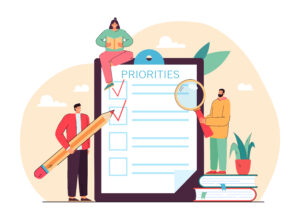 Scientific and health research lends itself to viewing the world in either/or perspectives: data either refute or support a particular hypothesis, sometimes based on statistical tests that indicate “different or not different”. However, it can be distressing when data don’t fit into tidy boxes, and might even create uncertainty in how to move forward.
Scientific and health research lends itself to viewing the world in either/or perspectives: data either refute or support a particular hypothesis, sometimes based on statistical tests that indicate “different or not different”. However, it can be distressing when data don’t fit into tidy boxes, and might even create uncertainty in how to move forward.
Like with research outcomes, many situations in our work and daily lives come with a spectrum of possibilities. If we default to believing that only two options can exist (either A or B; everything/all or nothing), then we typically constrain our decisions to reflect only those two options.
Adopting the use of “and” when they might normally default to saying “but” or “or” has helped a number of our clients to shift their approach to challenges as well as their understanding and empathy toward others. Here’s how to move from an all-or-nothing perspective that can hold you back to a new perspective that can unlock your potential.
Understanding Binary Thinking
Humans have complex thoughts, and to help us navigate a world of threats (not so much the saber-toothed tiger kind, but threats nonetheless), we often simplify complex information into binary choices. For example, an academic PI might think, “If I don’t get this grant, my career is over,” or “I can either publish in high-impact journals or have a work-life balance, but not both.” This type of thinking can be limiting and damaging, causing stress and hindering progress. Some consequences of this perspective include:
- Burnout: Constantly striving for an unattainable ideal can result in chronic stress and burnout.
- Missed Opportunities: Limiting oneself to a binary choice can cause missed opportunities for growth and collaboration.
- Stagnation: All-or-nothing thinking can lead to a lack of innovation and creativity, as it discourages exploring alternative solutions.
Embracing a Both/And Perspective
In contrast, a both/and perspective acknowledges the complexity of issues and seeks to integrate multiple viewpoints and solutions. This mindset encourages flexibility, resilience, and a more balanced approach to problem-solving. Here are some benefits of adopting a both/and perspective:
- Enhanced Creativity: By considering multiple possibilities, researchers can develop more innovative and comprehensive solutions.
- Improved Collaboration: A both/and mindset fosters a collaborative environment where diverse ideas and approaches are valued.
- Greater Resilience: Embracing complexity helps individuals adapt to changing circumstances and setbacks more effectively.
Applying Both/And Thinking in Academic Research Careers
For any aspect of your life, try to have awareness when you find yourself defaulting into an either/or perspective. Ask yourself,
- “Are these two possibilities the only possibilities?” Often, we forget about the gray areas.
- “What happens if I swap ‘or’ for ‘and’?” More than one thing can be true at a time (especially if we’re talking about ours or other people’s feelings or perspectives), so it can be helpful to recognize that.
Awareness can be enough to release some of the anxieties associated with either/or thinking. This awareness can also be useful to guide your decisions and behaviors.
Here are practical ways research faculty can incorporate a both/and perspective into their work life:
- Reframe Goals: Instead of seeing goals as mutually exclusive, find ways to integrate them. For example, aim to achieve both high-quality research and a healthy work-life balance by setting realistic expectations and boundaries.
- Prioritize Flexibility: Recognize that priorities may shift over time and be open to adjusting plans as needed. This flexibility can help manage stress and maintain productivity.
- Encourage Diverse Perspectives: Foster a culture of collaboration by valuing and incorporating diverse viewpoints. This approach can lead to more innovative research and a richer academic environment.
- Balance Immediate and Long-Term Goals: While it’s important to address urgent tasks, don’t lose sight of long-term objectives. Allocate time for both immediate responsibilities and strategic planning to ensure sustained progress.
- Practice Compassion for Self and Others: Acknowledge that perfection is unattainable and that making mistakes is part of the learning process. Be kind to yourself and your colleagues, and focus on continuous improvement rather than achieving an impossible ideal.
Case Study: Integrating Both/And Thinking
In our recent work with one PI, Dr. Long, it became clear that she believed that she had to choose either to say yes to all work requests that came her way (making clear to colleagues that she is fully committed to research, teaching, and service) or to have some time to care for herself and her well-being. This mindset led to long hours, high stress, and a decline in both her work quality and health, which led her to question how much longer she could really stay in academia.
 Dr. Long, of course, knew that this approach was not sustainable, but wasn’t sure how to fix it. An awareness that it is both possible to show dedication to the career and care for her well-being created a shift whereby Dr. Long began to prioritize her well-being alongside her professional goals. She implemented time management strategies, such as blocking out dedicated “deep work” time and scheduling regular recharge breaks. She also created a system to keep herself from overcommitting and overstretching herself and identified ways to delegate.
Dr. Long, of course, knew that this approach was not sustainable, but wasn’t sure how to fix it. An awareness that it is both possible to show dedication to the career and care for her well-being created a shift whereby Dr. Long began to prioritize her well-being alongside her professional goals. She implemented time management strategies, such as blocking out dedicated “deep work” time and scheduling regular recharge breaks. She also created a system to keep herself from overcommitting and overstretching herself and identified ways to delegate.
As a result, Dr. Long is no longer feeling utterly depleted by work, which translates to experiencing reduced anxiety and stress, more job satisfaction, and improved productivity. This shift is allowing her to see that she can have a fulfilling academic career without sacrificing her well-being.
Conclusion
All-or-nothing, either/or thinking can significantly hinder progress and well-being in academic research careers. By adopting a both/and perspective, research faculty can embrace complexity, enhance creativity, and achieve a more balanced and fulfilling professional life. Integrating this mindset into daily practice requires intentionality and effort, but the rewards are well worth it.
If you’re ready to transform your approach and unlock your full potential, consider how you can start incorporating both/and thinking into your work today. Your future self—and your research—will thank you.
